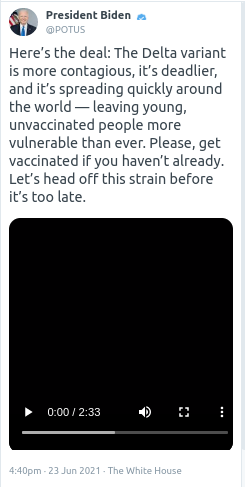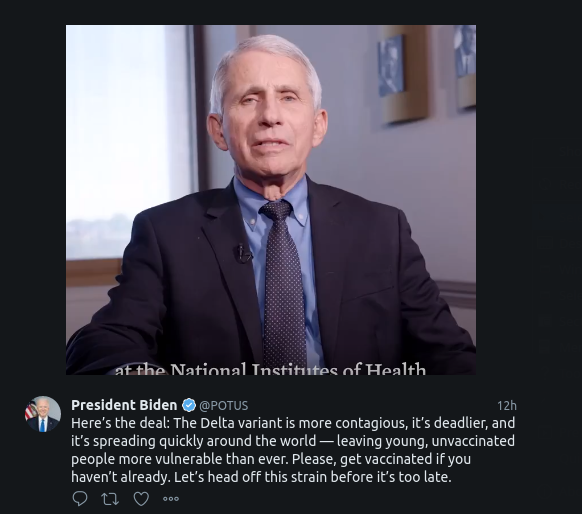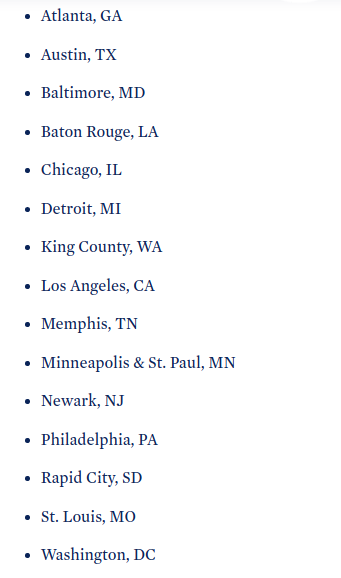
It’s Thursday.
For Thursday, June 24th, 2021, the President has received his daily brief. This afternoon he will travel to North Carolina, to tour a vaccination center. This evening he will deliver remarks about the importance of getting vaccinated.
We have our first deleted and reissued tweet to report this Thursday morning.
This tweet was first issued on Wednesday night.


Screen shot taken from Tweet Deck. 06/24/2021.
I really have no idea why the tweet was deleted, unless, there was a problem with the video they shared. I saw the tweet yesterday via Tweet Deck, but I didn’t play the video.
The video is two minutes and nine seconds long. It features Dr. Anthony Fauci.
After he introduces himself he says, “I’m here to talk to you today about the Delta variant that causes COVID-19.”
Q: What is the Delta variant?
Dr. Fauci says: Well the Delta variant compared to, for example the original virus that had been circulating very early on last year, the comparison is that it is transmitted much more efficiently, which means the chances of getting infected upon exposure is greater to the dominant variant that we have now in the United States.
Q: Who is most at risk?
Dr. Fauci says: Well anyone who is not vaccinated is most at risk. Younger people are less likely to be vaccinated, that puts the entire cohort of younger people at greater risk.
Q: What does it mean that the CDC has named this a variant of concern?
Dr. Fauci says: Based on the data that this virus transmits more easily and can be more dangerous, has been the underlying reason why they’ve made that change and upgraded it as it were to a “variant of concern”.
Q: What is the level of protection the vaccine gives against the Delta variant?
Dr. Fauci says: The vaccines are over 90 percent effective as much as 93, 94, 95 percent effective. So it’s really good against infected and getting sick at all and it’s very good against protecting you against severe disease that might result in hospitalization.
Q: How do we stop this variant of the virus?
Dr. Fauci says: Well there’s no doubt about it that the way you stop this Delta variant is to get vaccinated. We are trying to make getting vaccinated as easy as possible. Just go to vaccines.gov., and you’ll find out exactly what the closest place for you to conveniently get vaccinated is.
When Wednesday’s Open Thread was published, President Biden had not tweeted. He, minus the deleted/reissued tweet, tweeted 3 times and retweeted 0 times.
All three tweets are regarding his Administration’s gun crime prevention strategy.
First up is the live stream to his remarks.
The video is 30 minutes and 3 seconds long. AG Garland speaks first from the 28 second mark and concludes speaking at the 8 minute and 17 second mark. President Biden begins his remarks at the 8 minute and 22 second mark. The transcript includes both AG Garland’s remarks and President Biden’s.
His next tweet is not a direct quote from his remarks.
The text below is the closest we come to being related to the tweet.
President Biden: And we discussed a comprehensive strategy that I’m releasing today to combat the epidemic of gun violence and other violent crime that we’ve been seeing in our country for far too long, that has spiked since the start of the pandemic over a year ago. Crime has — historically rises during the summer. And as we emerge from this pandemic with the country opening back up again, the traditional summer’s — summer spike may even be more pronounced than it usually would be.
This is from the fact-sheet that announced the comprehensive strategy to prevent and respond to gun crime.
President Biden believes that the surge in gun violence that has affected communities across the country over the last year and a half is unacceptable, and his Administration is moving decisively to act with a whole-of-government approach as we enter the summer months when cities typically experience a spike in violence.
Today, the Biden-Harris Administration is announcing a comprehensive strategy to combat gun violence and other violent crime. This strategy implements preventative measures that are proven to reduce violent crime, and attacks the root causes – including by addressing the flow of firearms used to commit crimes.
This strategy will use the Rescue Plan’s historic funding levels and clear guidance to help state, local, territorial, and tribal governments get the money they need to put more police officers on the beat – with the resources, training, and accountability they need to engage in effective community policing – in addition to supporting proven Community Violence Intervention programs, summer employment opportunities, and other investments that we know will reduce crime and make our neighborhoods safer.
The strategy will also address the direct link between gun violence and the rise in violent crime by taking immediate steps to keep guns out of the wrong hands, including by strengthening ATF’s efforts to stem the flow of firearms used in crimes, and by launching multijurisdictional firearms trafficking strike forces to stop illegal gun trafficking across state lines.
White House.gov. 06/23/2021.
For his last Wednesday tweet he bullet points items from the fact-sheet linked above.
Stem the flow of firearms:
The Biden Administration is taking action to help stem the flow of guns into the hands of those responsible for violence by:
Establishing zero tolerance for rogue gun dealers that willfully violate the law. Gun dealers across the country are regulated by federal law that is enforced by the Bureau of Alcohol, Tobacco, Firearms and Explosives (ATF). Dealers that fail to comply with their obligations under the law create risks for all of us. Today, the Justice Department is announcing a new policy to underscore zero tolerance for willful violations of the law by federally licensed firearms dealers that put public safety at risk. Absent extraordinary circumstances that would need to be justified to the Director, ATF will seek to revoke the licenses of dealers the first time that they violate federal law by willfully 1) transferring a firearm to a prohibited person, 2) failing to run a required background check, 3) falsifying records, such as a firearms transaction form, 4) failing to respond to an ATF tracing request, or 5) refusing to permit ATF to conduct an inspection in violation of the law.
In addition, ATF will notify every firearms dealer whose license is revoked about how to lawfully transfer any remaining inventory, as well as the potential criminal consequences of continuing to engage in the business of buying and selling guns without a license. The prior Administration stopped this important notification practice that helps deter future unlawful activity.
Maximizing the efficacy of ATF resources to crack down on rogue gun dealers violating our laws. The Administration continues to call on Congress to increase funding for ATF to hire additional personnel necessary to increase the number of inspections and enforcement actions taken against dealers in violation of federal law. The President’s FY 22 budget request would allow ATF to add inspectors in every field division around the country. In the meantime, ATF is announcing the following actions to increase the efficacy of its existing, limited resources:
White House.gov. 06/23/2021.
- Better coordination with state and local officials with on-the-ground knowledge of which dealers are supplying firearms that show up at crime scenes. ATF has designated a specific point of contact in every field division for mayors, police chiefs, or other local leaders to report concerns about particular dealers’ compliance with the law. This information may provide valuable leads for ATF investigations and serve as a source of information that helps focus inspection resources on the places that need them most.
- Formalizing the use of data-driven prioritization of inspection resources. Starting today, ATF will make clear to investigators in every field division—through trainings and guidance—that when identifying inspection priorities they must consider a number of factors related to public safety, including the extent to which firearms sold by the dealer are later used in criminal activity; the time between the sale of a firearm and its use in a crime; the number of recoveries associated with shootings, domestic violence, and other violent offenses; and additional information developed by local law enforcement partners. This data-driven prioritization will allow ATF to target its limited inspection resources to ensure compliance with federal law.
- Equipping states that have their own gun dealer licensing systems with data from ATF inspections. Sixteen states license or regulate firearms dealers themselves, and their inspection systems can be force multipliers in protecting public safety. Starting next month, ATF will begin sharing inspection data with these states so that officials there can determine whether to take their own steps to shut down dealers that fail to live up to their obligations under state law.
Launching multijurisdictional firearms trafficking strike forces. The Biden-Harris Administration recognizes that the federal government has a critical role to play in coordinating multijurisdictional enforcement efforts to stop the illegal flow of firearms across state lines. Yesterday, the Justice Department announced that it is launching five new law enforcement strike forces focused on addressing significant firearms trafficking corridors that have diverted guns to New York, Chicago, Los Angeles, the Bay Area, and Washington, D.C. These strike forces, which will launch within the next 30 days, will be led by designated United States Attorneys who will coordinate not only with ATF but also with state and local law enforcement partners in places where firearms originate and where they are used to commit crimes. The strike forces will share information and otherwise coordinate their efforts across districts where firearms trafficking schemes cross state or jurisdictional boundaries. As part of this effort, ATF is issuing a best practices guide for law enforcement agencies that will include specific questions that officers should ask unlawful firearm possessors to help identify sources of trafficked crime guns.
Providing the public with additional data to promote transparency and accountability in enforcement of federally licensed firearms dealer policies. ATF will publicly post more detailed information about inspection findings and enforcement actions. For the first time, this publicly posted data will be disaggregated to show the number of inspections conducted in each field division, the number of inspections that identified violations, and actions taken by ATF to implement the willful-violation policy discussed above (including any application of the extraordinary circumstances exception). This data will promote transparency and accountability for the enforcement of our existing gun laws.
Stemming the proliferation of “ghost guns” and modified firearms. During the April address in the Rose Garden by the President and Attorney General, the Justice Department announced that it was beginning the rulemaking process to help stop the proliferation of dangerous firearms that are currently circumventing our gun laws. The Justice Department has since issued two proposed rules to follow through on this commitment. First, the Justice Department issued a proposed rule to help address the proliferation of “ghost guns,” which are homemade firearms that are increasingly ending up at crime scenes and often cannot be traced by law enforcement due to the lack of a serial number. Second, the Justice Department issued a proposed rule to make clear when a device marketed as a stabilizing brace effectively turns a pistol into a short-barreled rifle subject to the requirements of the National Firearms Act. Modifying a pistol with an arm brace can make a firearm more stable and accurate while still being concealable.
Convening state legislators and Attorneys General regarding policy strategies to hold gun dealers and manufacturers accountable for their contributions to the flow of crime guns. The President continues to call on Congress to repeal the Protection of Lawful Commerce in Arms Act (PLCAA), which gives gun dealers and manufacturers special immunity from certain liability for their products. In the meantime, the White House will convene state legislators and Attorneys General to discuss strategies for enacting and employing state liability laws that can be used to hold dealers and manufacturers accountable for improper conduct not covered by PLCAA.
These actions are part of the Biden-Harris Administration’s comprehensive strategy to reduce gun violence through executive action and legislation. For example, earlier this month the Justice Department issued model state “red flag,” or “extreme risk protection order,” legislation. Extreme risk protection order laws allow family members or law enforcement to petition for a court order temporarily barring people in crisis from accessing firearms if they present a danger to themselves or others. The President urges Congress to pass an appropriate national “red flag” law, as well as legislation incentivizing states to pass their own versions of these laws.
The President again strongly urges the Senate to ban assault weapons and high-capacity magazines, and pass the three House-passed, bipartisan pieces of legislation which would strengthen our gun background check system.
White House.gov. 06/23/2021.
Advance community policing:
The President is also seeking a $300 million increase for the Community Oriented Policing Services (COPS) Hiring program in his recent budget request. These funds will advance community policing and give police the resources they need to keep their communities safe.
White House.gov. 06/23/2021.
Invest in evidence-based community violence interventions:
Invest in evidence-based community violence interventions
Community violence intervention (CVI) programs have been shown to reduce violence by as much as 60%. These programs are effective because they leverage trusted messengers who work directly with individuals most likely to commit gun violence, intervene in conflicts, and connect people to social, health and wellness, and economic services to reduce the likelihood of violence as an answer to conflict.
Last month, the Treasury Department announced that the American Rescue Plan’s $350 billion in state and local funding can be used to invest in evidence-based community violence interventions. The Department of Education also released guidance clarifying that ARP’s $122 billion in K-12 funds can be used for CVI strategies. To date, the Administration has transferred more than $190 billion of state and local recovery funds and $81 billion in education funds, and additional support is on the way.
Today, the President is announcing that the Administration will convene and support a CVI Collaborative of 15 jurisdictions that are committing to use a portion of their ARP funding or other public funding to increase investment in their CVI infrastructure, including to anticipate and respond to the potential rise in violence this summer. These jurisdictions include:
White House.gov. 06/23/2021.

Over the next 18 months, the Administration will convene meetings with officials from these communities, facilitate peer-to-peer learning, and provide technical assistance. This effort will support both proven and new strategies that reduce gun violence and strengthen community-based infrastructure to enhance public safety for children, families, and communities and to advance equity. A group of philanthropies that have been leaders on this issue will support this collaborative learning network by deploying CVI experts to provide training and technical assistance, identify best practices, integrate proven and innovative public-health approaches, and help local community-based organizations scale CVI efforts this summer and beyond.
Domestic Policy Advisor Susan Rice and Director of Intergovernmental Affairs Julie Chavez Rodriguez will convene the first meeting of the CVI Collaborative soon. The President is calling on mayors across the country to follow the lead of these local officials by using their ARP funding or other public funds to launch and strengthen CVI programs in their communities.
Additionally, the Biden-Harris Administration will convene the first CVI Webinar Series event on June 23 [that was yesterday]. The webinar series will bring together subject matter experts to discuss immediate steps communities and local organizations can take to reduce violence.
The Administration is continuing to seek a historic $5.2 billion investment in new grant funding for CVI programs through the American Jobs Plan and its FY22 discretionary budget request. The Administration is also executing on its announced changes to 26 programs across five agencies to make federal dollars and technical assistance available to CVI practitioners in the immediate term. For example, this month the U.S. Department of Housing and Urban Development (HUD) will publish guidance encouraging jurisdictions to use part of their Community Development Block Grant funds to support CVI efforts needed to combat violence as a result of the coronavirus pandemic. In July and August, the Department of Education will publish guidance explaining that school districts can draw upon the $1.22 billion in Student Support and Academic Enrichment grants and $1.26 billion in 21st Century Community Learning Centers grants to support CVI programs that serve students. This funding will supplement American Rescue Plan funds, providing CVI programs with multiple potential funding streams to expand their work.
White House.gov. 06/23/2021.
Expand summer programming, employment opportunities, and other services and supports, especially for teenagers and young adultsExpand summer programming, employment opportunities, and other services and supports, especially for teenagers and young adults:
American Rescue Plan Funds. The Administration released guidance from the Department of the Treasury today and from the Department of Education last week explaining how two buckets of American Rescue Plan funding—$350 billion in state and local funding and the $122 billion in school funding—can be used for a variety of public safety strategies. Within the parameters explained in those guidance documents, State and territory, local, and Tribal governments can:
White House.gov. 06/23/2021.
- Hire support personnel such as nurses, counselors, and social workers;
- Pay court personnel and operations costs to return to pre-pandemic operation levels;
- Provide and expand employment services, including summer jobs for young people and programs that provide training and work experience for formerly incarcerated persons and other individuals who live in communities most impacted by high levels of violence;
- Provide and expand summer education and enrichment programs, including summer camp;
- Scale up wraparound services—such as housing, medical and mental health care, trauma-informed care, substance use disorder treatment, food assistance, and job placement services—for victims of crime, young people, formerly incarcerated persons, and individuals and households facing economic insecurity due to the pandemic; and
- Establish or expand full-service community schools.
There is more at the White House fact-sheet link.
In other news…
*snort*
Also this…
President Biden’s remarks are scheduled for 5:15 p.m. D.C., time.
This is an open thread
Update:
Breaking news: President Biden has announced that he and a bipartisan group of lawmakers have reached a deal on the American Jobs Plan.
More information will follow.
